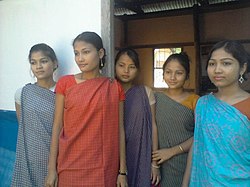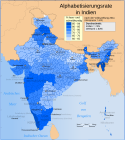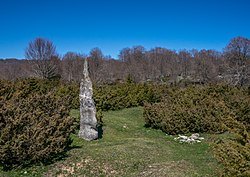Folk-tales of the Khasis (1920) (14800178403)
Identifier: folktalesofkhasi00rafy (find matches)
Title: Folk-tales of the Khasis
Year: 1920 (1920s)
Authors: Rafy, K. U
Subjects: Khasi (Indic people) Folklore -- India
Publisher: London : Macmillan and Co., Limited
Contributing Library: University of California Libraries
Digitizing Sponsor: MSN
View Book Page: Book Viewer
About This Book: Catalog Entry
View All Images: All Images From Book
Click here to view book online to see this illustration in context in a browseable online version of this book.
Text Appearing Before Image:
n erratic and insignificant being whohaunted the forest of Lait-rngew to the north of Cherra.The khans hitherto had never recognised him asworthy of homage, but they went to offer him sacrificesthen, according to the divinations. U Suidnoh volun-teered to rescue them, but affirmed that the Snakecould never be overcome without the sanction of aBlei, and inasmuch as the Bleis of the Cherra Himahad already refused their aid, he urged them to go andsacrifice to U Lei Shillong—the god of the Shillongmountain—and to invoke his aid and win his favour.So mankind offered sacrifices to U Lei Shillong, andreceived his sanction to wage war against U Thlen. U Suidnoh, equipped in all his strength, went forthto Pomdoloi and ordered the Khasis to bring to himmany fat pigs and goats. These he killed and carriedregularly to feed the Thlen in the cave, and this wastiie manner in which he made his offering. He boreda large hole in a rock roofing the cave, so that the U THLEN, THE SNAKIvYAMIM l!K fi3
Text Appearing After Image:
FOLK TALKS OF THE KIIASIS xn might I- passed dowD without being seen byl Thlen, and bo he would doI discover that they werenot human bodies. He assumed the voice and manneroi a Thlen worshipper and called out : My uncle. I have brought my tribute, open your mouth that I mayfeed you. 0 Thlen i> described as being slothful andsleepy, never rousing himself except to seek food. When he heard the call from above he would shake himself and expand to a great size, and open wide his jaws, into which the meat offering was thrust. In thisway mankind had respite for a time, and the huntingof men ceased. It was evident, however, that they must resort tosome other measures, for it was impossible to continueto keep up the supply of fat animals. The Khasisbegan to grumble at the extravagant proceedings otD Suidnoh, but he always replied to their complaintswith the words, Koit, koit signifying that all was well.After a time he told them to hire the services of UEtamhah, the giant, to assist him in
Note About Images
Relevante Bilder










































Relevante Artikel
KhasiDie Khasi – Eigenname Ki Khasi oder Ki Khun U Hynniewtrep – sind ein indigenes Volk im Nordosten von Indien mit über 1,4 Millionen Angehörigen im kleinen Bundesstaat Meghalaya in den Vorläufern des Himalaya-Gebirge. Sie bilden dort etwa die Hälfte der Gesamtbevölkerung. Rund 35.000 Khasi leben im benachbarten Bundesstaat Assam und etwa 100.000 im südlich angrenzenden Bangladesch. Die Khasi bilden eine matrilineare Gesellschaft über Mütterlinien, bei denen Abstammung, Familienname und Erbfolge nur von der Mutter hergeleitet werden, nicht vom Vater. Diese Verhältnisse sind in der Verfassung von Meghalaya verankert, auch für das matrilineare Nachbarvolk der Garo; beide haben den Staat im Jahr 1972 begründet, die indische Verfassung garantiert ihnen besondere Schutz- und Selbstverwaltungsrechte als „registrierte Stammesgemeinschaften“. Nach der Khasi-Tradition liegt der Besitz von Grund und Boden nur in den Händen von Frauen, er sichert den Müttern und ihren Großfamilien soziale und wirtschaftliche Selbständigkeit und Absicherung. Männer gehören zur Großfamilie ihrer Mutter, erben von ihr den Familiennamen und die Clan-Zugehörigkeit und tragen zu ihrem Unterhalt bei; sie sind Teil der Solidargemeinschaft, können aber normalerweise kein Land erben. Nach einer Heirat zieht der Ehemann meist zu seiner Ehefrau und ihrer Mutter, seine Kinder werden ihrer Großfamilie zugehören. Der Bruder der Ehefrau gilt als ihr Beschützer und Berater und wird sich traditionell als sozialer Vater um ihre Kinder kümmern. .. weiterlesen
MenhirMenhir ist eine aus dem Bretonischen entlehnte Bezeichnung für einen vorgeschichtlichen, hochragenden Steinblock, der auch als Hinkelstein bekannt ist. In der prähistorischen Archäologie bezeichnet das Wort einen länglichen Einzelstein, der in vorgeschichtlicher Zeit von Menschen aufrecht gestellt wurde. Die Identifikation als Menhir ist oft nur durch eine Ausgrabung zu verifizieren. Aufrechte Steine dienten auch als Grenzsteine, Ruhsteine, Werbung für Steinbrüche, moderne Gedenksteine und Gartenornamente sowie als Markierung von Straßen. .. weiterlesen
